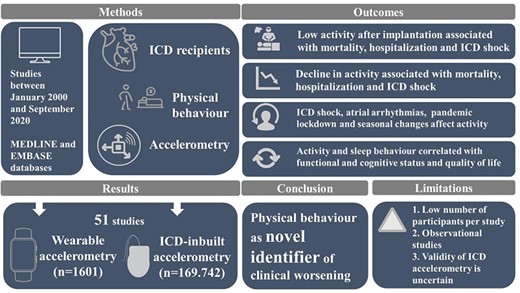-
PDF
- Split View
-
Views
-
Cite
Cite
MZH Kolk, DM Frodi, TO Andersen, J Langford, SZ Diederichsen, JH Svendsen, HL Tan, RE Knops, FVY Tjong, Accelerometry-assessed physical behaviour and the association with clinical outcomes in implantable cardioverter-defibrillator recipients: a systematic review, EP Europace, Volume 23, Issue Supplement_3, May 2021, euab116.415, https://doi.org/10.1093/europace/euab116.415
Close - Share Icon Share
Abstract
Type of funding sources: Public grant(s) – EU funding. Main funding source(s): Eurostars
Patients at a high risk of sudden cardiac death (SCD) benefit from an implantable cardioverter defibrillator (ICD). However, they remain at a high risk of (inappropriate) shocks, heart failure, mortality and psychological distress. Consumer-level wearable accelerometry as method for recording physical behaviour (PB) has gained popularity over the past years, but so far the clinical potential is largely underinvestigated. The identification of patterns in PB and the association with clinical outcomes may provide a means to improve ICD therapy.
This review addresses the evidence concerning PB in ICD patients and aims to characterise PB patterns associated with clinical outcomes.
A systematic review of studies focussing on accelerometer-assessed PB in patients older than 18 years equipped with an ICD, or patients at a high risk of SCD (e.g. advanced heart failure) was performed. PB could be assessed using a wearable accelerometer or an embedded accelerometer in the ICD (i.e. device-measured physical activity (D-PA)). Papers presenting quantitative data in English language peer reviewed journals published between January 2000 and September 2020 were identified via the OVID MEDLINE and OVID EMBASE databases. A study protocol describing study selection, data charting and summarisation of results was developed apriori. Study selection was conducted by two independent reviewers and a third reviewer in case of disagreement.
A total of 4219 studies were identified, of which 51 were deemed appropriate for this review. Of these studies, 29 examined D-PA (n = 169.742 patients), 19 examined wearable accelerometery (n = 1.601) and 3 validated wearable accelerometry against D-PA (n = 106). The main findings were that (i) a low level of physical activity (PA) after implantation of the ICD and (ii) a decline in physical activity were both associated with an increased risk of ICD shocks, hospitalization and mortality. Second, PB was affected by cardiac factors (e.g. onset of atrial arrhythmias, ICD shocks) and non-cardiac factors (e.g. seasonal differences, pandemic lockdown). Third, PB was related to left ventricular ejection fraction, physical and cognitive function and quality of life. The evidence regarding wearable accelerometry compared to D-PA was scarce and heterogeneous.

Abstract Figure. Accelerometry-derived physical behaviour
- physical activity
- left ventricular ejection fraction
- sudden cardiac death
- atrial arrhythmia
- implantable defibrillators
- heart failure
- heterogeneity
- medline
- mental processes
- behavior
- heart
- mortality
- quality of life
- treatment outcome
- inappropriate shocks from implanted defibrillator
- pandemics
- medical devices
- cognitive ability
- accelerometers
- psychological distress
- early warning scoring system
- prevention
- advanced heart failure
- english
- embase
- clinical deterioration
- reviewers



